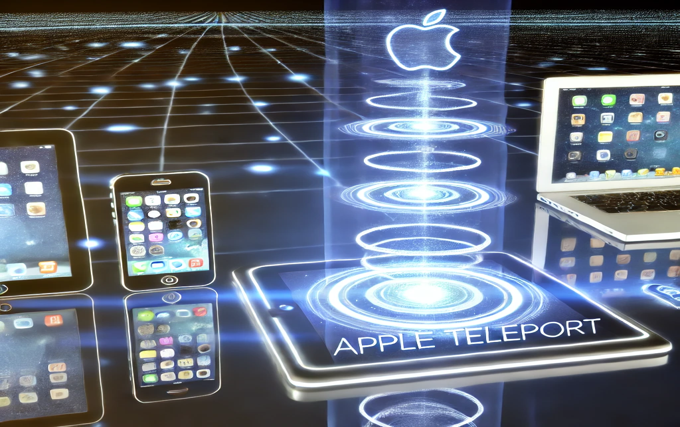The idea of teleportation has long fascinated humanity, appearing in science fiction as a tool for effortless travel across vast distances. While teleportation in its most literal sense remains within the domain of speculative fiction, recent technological advancements are making the concept more plausible—at least virtually. One of the latest rumored projects in the tech world is “Apple Teleport.” This concept has ignited considerable speculation about Apple’s potential involvement in the next evolution of seamless, interconnected technology. In this article, we’ll dive deep into what Apple Teleport could entail, explore its possible implications, and discuss how it aligns with Apple’s broader ecosystem of devices and services.
What is Apple Teleport?
Apple Teleport is a concept that suggests the integration of ultra-fast, real-time connectivity across all Apple devices, enabling users to move between devices and locations as if they were one cohesive system. Imagine initiating a task on your iPhone and instantly picking it up on your MacBook without any lag or delay. Even more revolutionary is the potential for these devices to interconnect with augmented reality (AR) and virtual reality (VR) technologies, creating immersive experiences that feel almost teleportative.
The Core Concept of Apple Teleport
Apple Teleport is expected to push beyond existing continuity features, such as Handoff, AirDrop, and Universal Control, which already allow seamless interaction within the Apple ecosystem. This new level of connectivity would involve merging device data and applications with the aid of cloud computing, artificial intelligence, and possibly new, innovative hardware. At its core, Apple Teleport could redefine connectivity by focusing on three main pillars:
- Instantaneous Continuity: Expanding the seamless transition of tasks across devices.
- Immersive Experiences: Incorporating AR and VR to bring physical and digital worlds closer.
- Unifying Ecosystem: Creating a fully integrated Apple environment where all devices communicate flawlessly, offering an almost “teleportative” feel.
The Technology Behind Apple Teleport
To achieve such an ambitious project, Apple would need to harness a series of cutting-edge technologies. Here are some components likely to be involved in Apple Teleport:
1. 5G and 6G Connectivity
High-speed data transmission is essential for real-time interactions across devices. With 5G already rolling out and research underway for 6G, the era of nearly instantaneous data transmission is approaching. Apple Teleport would likely rely on these advanced networks to maintain seamless connectivity, allowing data to flow freely between devices regardless of location.
2. Augmented Reality (AR) and Virtual Reality (VR)
Apple has already hinted at its interest in AR and VR, especially with the announcement of Apple Vision Pro. Apple Teleport could leverage these technologies to create immersive experiences that feel almost like teleportation. Users could be “transported” into virtual spaces for work, entertainment, or social interaction. Imagine attending a virtual meeting with a friend in Tokyo, where both participants feel present despite being miles apart.
3. Cloud Computing and Artificial Intelligence (AI)
Cloud computing and AI are crucial for synchronizing data and providing predictive capabilities. For Apple Teleport, cloud-based AI could anticipate the user’s needs, providing an intuitive experience that enhances productivity and entertainment. The cloud would store data, while AI algorithms would ensure that users could pick up exactly where they left off on any device.
4. Device Mesh Networks
In a mesh network, multiple devices communicate directly with each other rather than routing through a central hub. With a robust mesh network, Apple Teleport would ensure reliable, low-latency connections, enabling a genuinely synchronized experience. This would be especially useful for households or workspaces with multiple Apple devices, creating an environment where all devices work as one.
Potential Applications of Apple Teleport
1. Unified Workspace Experience
Apple Teleport could be transformative for remote work, a trend that has seen unprecedented growth in recent years. Imagine starting a presentation on your iPad at home, walking into your office, and seamlessly continuing it on a Mac without any interruption. This kind of unified workspace would significantly boost productivity and offer a frictionless workflow.
2. Enhanced Gaming Experiences
With VR and AR becoming mainstream, Apple Teleport could introduce the concept of teleportative gaming, where players experience real-time transitions between devices and environments. For example, you could start a game on an Apple TV, switch to your iPhone when on the go, and continue the experience without any interruption. Such fluidity could be a game-changer for the gaming industry, especially with the rise of AR-based mobile games.
3. Medical and Educational Uses
Apple Teleport could open new possibilities in telemedicine and virtual classrooms. Doctors could access and share patient information in real time across devices, enabling them to work remotely with precision and speed. In education, students could interact with virtual classrooms through their devices, moving seamlessly between home and school environments without loss of information or productivity.
4. Social Interactions and Communication
Apple Teleport could redefine digital social interactions. Imagine FaceTiming with someone and being able to “teleport” them into your environment through AR. Users could also potentially host VR gatherings, where friends or colleagues join from remote locations, creating a feeling of togetherness that transcends traditional video calls.
How Apple Teleport Fits into the Apple Ecosystem
The beauty of Apple Teleport lies in how well it fits within Apple’s ecosystem, a closed-loop network where each device complements the other. Here are some ways Apple Teleport could strengthen this ecosystem:
1. Extending Continuity Features
Apple has already introduced features like Handoff, Sidecar, and Universal Control to help users switch between devices with ease. Apple Teleport could extend these features, making transitions even smoother and allowing for real-time cross-device interactions without delay. It could even connect seamlessly with Apple’s new spatial computing device, Vision Pro, creating a unified and immersive experience.
2. Integration with iCloud and Apple ID
iCloud already plays a central role in unifying data across Apple devices. Apple Teleport’s could take iCloud integration to the next level, enabling users to sync experiences, preferences, and applications across devices instantaneously. By linking it with a user’s Apple ID, the ecosystem would become highly personalized, with data and services tailored to individual preferences.
3. Revolutionizing App Experiences
Developers could leverage Apple Teleport’s to create applications that run seamlessly across multiple Apple devices. Apps could deliver cross-device functionalities that would allow users to experience an app in its entirety across various devices, transforming workflows and improving productivity. For example, a video editing app could allow users to edit a video on their Mac and then view it in AR on an iPhone.
Potential Challenges and Concerns
While Apple Teleport’s sounds revolutionary, it would inevitably face challenges in implementation:
1. Privacy and Security
Apple is known for its strong focus on user privacy, and Apple Teleport’s would need to ensure that data flows securely across devices. With data being shared in real-time, Apple would need to enhance encryption and introduce strict access controls to prevent unauthorized access.
2. Device Compatibility
Apple Teleport would likely require hardware upgrades to handle the level of real-time connectivity required. Older devices may not be able to support such advanced features, potentially limiting accessibility for some users. Apple may introduce the technology gradually, focusing on newer models and eventually extending it to other devices.
3. Network Dependence
Apple Teleport would heavily rely on high-speed networks, especially 5G and future 6G. However, users in areas with limited internet connectivity might not experience the full potential of Apple Teleport, which could limit its reach globally.
4. Battery and Processing Power
Constant synchronization and real-time connectivity could drain device batteries faster and require more powerful processors. This means Apple may need to invest in new power-efficient processors or advanced battery technology to ensure that devices can handle Apple Teleport without compromising user experience.
The Future of Apple Teleport
While Apple has not officially confirmed Apple Teleport, the company’s emphasis on interconnected ecosystems and innovation makes this concept plausible. If successful, Apple Teleport’s could redefine how we perceive and use digital devices, making them extensions of our physical world. Such technology could reshape the way we work, play, and interact, bridging the gap between reality and virtual experiences.
When Can We Expect Apple Teleport?
Apple is known for its secrecy, but given its strides in augmented reality, virtual reality, and continuity features, a form of Apple Teleport’s could emerge within the next few years. It’s possible we could see incremental rollouts within the Apple ecosystem, perhaps starting with the Vision Pro and iPhone and gradually expanding to other devices.
Conclusion
Apple Teleport, if realized, could be a game-changing innovation. By integrating real-time connectivity, immersive AR and VR, and cloud-based synchronization, Apple could deliver a truly teleportative experience across its ecosystem. While challenges exist, Apple’s track record of technological breakthroughs suggests that such a concept is well within reach. Apple Teleport could be the next big step toward a world where distance and device barriers vanish, bringing us closer to a future that feels, quite literally, like teleportation.


